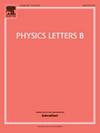扩展标量张量理论中量子质量诱导的黑洞标量化
IF 4.3
2区 物理与天体物理
Q1 ASTRONOMY & ASTROPHYSICS
引用次数: 0
摘要
在扩展标量-张量-高斯-邦纳(ESTGB)理论中,自发标量化在各种类型的黑洞中得到了广泛的研究。研究表明,在耦合常数为λ<;0的GB−区,自发标化通常发生在旋转黑洞中,这种现象被称为自旋诱导标化。最近,通过对量子奥本海默-斯奈德(qOS)引力坍缩模型的研究,提出了一个修正qOS的史瓦西黑洞。通过数值计算标量扰动的时间演化,我们首次得到了ESTGB理论中qos校正的史瓦西黑洞的自发标化区域。令人惊讶的是,我们发现GB−标化也可以发生在这个球对称黑洞中。我们把这种现象称为qos诱导的自发标化。我们的结果表明,随着耦合常数- λ/M2的增大,允许GB -尺度化的量子参数α/M2的范围增大。当−λ/M2较小时,GB−标化只能发生在黑洞极限附近。当−λ/M2趋近于∞时,λ/M2的下边界收敛到临界临界点(α/M2),该临界点可以解析得到。由于量子参数通常很小,我们的研究结果表明,自发尺度化主要影响微观黑洞,为早期宇宙、原始黑洞和量子黑洞的研究提供了有价值的见解。本文章由计算机程序翻译,如有差异,请以英文原文为准。
qOS-induced scalarization of black holes in extended scalar-tensor theories
In the extended scalar-tensor-Gauss-Bonnet (ESTGB) theory, spontaneous scalarization has been extensively studied in various types of black holes. Research indicates that in the GB− regime, where the coupling constant , spontaneous scalarization typically occurs in rotating black holes, a phenomenon known as spin-induced scalarization. Recently, by studying the quantum Oppenheimer-Snyder (qOS) gravitational collapse model, a qOS-corrected Schwarzschild black hole has been proposed. By numerically calculating the time evolution of scalar perturbations, we have, for the first time, obtained the spontaneous scalarization region for the qOS-corrected Schwarzschild black hole in the ESTGB theory. Surprisingly, we found that GB− scalarization can also occur in this spherically symmetric black hole. We refer to this phenomenon as qOS-induced spontaneous scalarization. Our results show that the range of the quantum parameter which allows GB− scalarization increases as the coupling constant grows. When is small, GB− scalarization can only occur near the extremal black hole limit. As approaches infinity, the lower boundary of for GB− scalarization converges to a critical value , which has been obtained analytically. Since the quantum parameter is typically small, our results suggest that spontaneous scalarization primarily affects microscopic black holes, offering valuable insights into the study of the early universe, primordial black holes and quantum black holes.
求助全文
通过发布文献求助,成功后即可免费获取论文全文。
去求助
来源期刊

Physics Letters B
物理-物理:综合
CiteScore
9.10
自引率
6.80%
发文量
647
审稿时长
3 months
期刊介绍:
Physics Letters B ensures the rapid publication of important new results in particle physics, nuclear physics and cosmology. Specialized editors are responsible for contributions in experimental nuclear physics, theoretical nuclear physics, experimental high-energy physics, theoretical high-energy physics, and astrophysics.
 求助内容:
求助内容: 应助结果提醒方式:
应助结果提醒方式:


